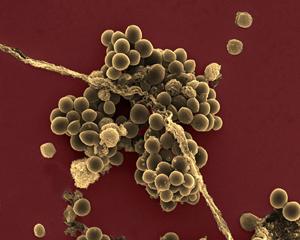Researchers at the Institut Pasteur, the CNRS, and the University of Tsukuba Faculty of Medicine (Japan) have proven for the first time that activating a specific gene in Staphylococcus aureus enables it to incorporate extracellular DNA and develop resistance to methicillin. They have also identified two mechanisms for the activation of the gene in question. These results represent an important step forward in the understanding of antibiotic resistance gene acquisition by S. aureus. This research was published in the journal PLoS Pathogens on November 1, 2012.
Press release
Paris, november 1st, 2013

Until now, the mechanisms behind the acquisition of antibiotic resistance genes by Staphylococci were unknown, but this recently changed when the team working under Tarek Msadek, researcher in the Biology of Gram-Positive Pathogens Unit (Institut Pasteur-CNRS), in collaboration with the Tsukuba University Faculty of Medicine, made an important discovery. The researchers were able to show for the first time that activation of a specific S. aureus gene, sigH, allows the bacterium to trigger a specialized machinery to capture DNA present in the environment and thus potentially acquire antibiotic resistance genes. They have also identified two distinct mechanisms for natural activation of the sigH gene. In their demonstration, after experimental activation of the sigH gene, the researchers succeeded in transforming a methicillin-sensitive S. aureus strain into a methicillin-resistant strain similar to those responsible for nosocomial infections.
These results suggest that inhibiting the sigH gene could be a promising approach towards preventing the proliferation of S. aureus strains with multiple antibiotic resistance.
--
Illustration: Copyright Institut Pasteur
Caption: a cluster of S. aureus bacteria observed using electron microscopy
Source
Expression of a cryptic secondary sigma factor gene unveils natural competence for DNA transformation in Staphylococcus aureus, PLoS pathogens, November 1, 2012.
Kazuya Morikawa (1,2), Aya J. Takemura (1), Yumiko Inose (1), Melody Tsai (1), Le Thuy Nguyen Thi (1), Toshiko Ohta (1), and Tarek Msadek (2,3)
(1) University of Tsukuba, Division of Biomedical Science, Faculty of Medicine, Tsukuba, Japan,
(2) Institut Pasteur, Biology of Gram Positive Pathogens, Department of Microbiology, Paris, France,
(3) CNRS ERL 3526, Paris, France
Contacts
Institut Pasteur Press Office
Nadine Peyrolo – +33 (0)1 45 68 81 46
Jérémy Lescene – +33 (0)1 45 68 81 01
presse@pasteur.fr


